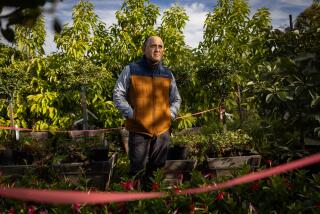Genes Not Linked to Life Span, Studies Say : Aging: Once thought to be predetermined, risk of dying levels off and decreases among flies. Scientists expect similar results in humans.
- Share via
The life spans of humans and other species may not be genetically predetermined, as scientists have long believed, but instead controlled by disease and other everyday risks of living, according to two new studies.
In studies of large numbers of fruit flies and Medflies, scientists in California and Minnesota found that the risk of dying, long thought to increase exponentially with age, leveled off and began to decline in old age.
“Our results suggest that the oldest individuals live progressively longer,” said UC Davis entomologist James R. Carey, lead author of the study involving Medflies.
“The pattern that is emerging is that there is no well-defined precise limit on life span,” said ecologist James Curtsinger of the University of Minnesota, lead author of the other report. “There is not an alarm that goes off and then you are dead.”
Although the new studies, reported today in the journal Science, deal with insects, the researchers believe that the unexpected results will apply to humans and other species.
“All species are subject to the same broad biological laws as humans,” Carey said. “Of course, it has to be cross-verified, but the patterns observed in flies can be extrapolated to humans.”
“That doesn’t mean that human beings are going to live to be 999 years of age starting tomorrow,” said population analyst James Vaupel of Duke University. “But if people began following good health practices today, they might live 90 years, or even 100 years, on average.”
These “extraordinarily novel studies . . . are surprising to me because it’s been a general tenet that mortality rates accelerate with age,” said sociologist Richard D. Suzman, chief of the National Institute of Aging’s Office of the Demography of Aging. If those results hold up in other species, he said, “that’s a new paradigm of aging.”
“In some ways, this study will define the next wave of research in the area of biological limits on aging,” demographer Kenneth Wachter of UC Berkeley said.
What separates the new research are the large numbers studied. Curtsinger and his colleagues looked at 11,000 fruit flies. Carey studied 1.2 million Medflies at a facility in Metapa, Mexico, where Medflies are raised and sterilized for eradication efforts in the United States and elsewhere.
In each group of flies studied, all were born on the same day. On each subsequent day the researchers counted the flies that died.
Initially, mortality rates climbed rapidly, reaching a peak of about 15% on Day 40, an old age for a Medfly. That means that each fly had a 15% chance of dying on that day.
Conventional wisdom said that the mortality rate should continue to increase, but that is not what was observed. Instead, it leveled off and declined. By Day 100, the remaining flies had only a 4% to 6% mortality rate--below the rate observed at Day 20 when the flies were in middle age.
The longest-lived fly survived 241 days, the equivalent of more than 200 years in humans.
Curtsinger saw a similar leveling off of mortality rates, but he did not observe a decline. That may be because he did not have enough flies, experts said.
Researchers had previously observed a slight trend to leveling off of mortality rates in beetles, houseflies and even humans, but critics “dismissed them as unimportant” because the numbers were so small, Carey said. “Now, with these results, gerontologists may have to go back and take a second look.”
But are results in Medflies relevant to humans? “There are principles of heredity, fundamental biological pathways that are the same in all living organisms,” Carey said. “Aging and senescence represent one of those pathways.”
These and other longevity studies strongly suggest that as new treatments for disease are developed, humans may be able to live far longer than most scientists had believed, researchers say.
In fact, limited studies in humans by Duke’s Vaupel, as well as other researchers, have revealed the beginnings of the same trends Carey observed in the Medflies. If this research is correct, it could have profound social and economic consequences.
Now, about 1% of the U.S. population is older than 85. By the middle of the next century, Vaupel and others predict, up to 20% of the population will be that old.




